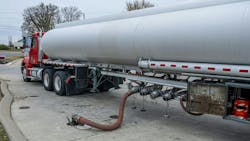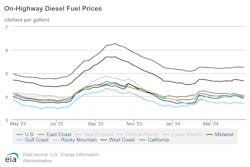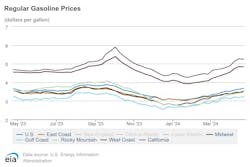Diesel hovers near $4/gal, while gas prices soar on East Coast
The week of April 22, the U.S. Energy Information Administration (EIA) found that nationwide diesel costs dropped once more, with the exception of some sub-regions of the East Coast. Overall, the U.S. on-highway diesel fuel price average reached $3.992 per gallon after dropping 2 cents from last week, and 8 cents from this period last year.
Most areas across the U.S. followed suit, save for the New England sub-region and the Atlantic sub-region, both of which saw prices increase 1 cent to $4.326 and $4.255 per gallon respectively. While diesel prices did not rise along the West Coast, California’s diesel prices only fell by 1 cent to $5.244, and the Gulf Coast’s diesel costs also only fell by less than a cent to $3.707 per gallon. Similarly, the East Coast overall saw its prices drop 2 cents to $4.047.
But in other locales, the Rocky Mountain region saw its diesel costs drop by 7 cents to $3.883 per gallon, and the West Coast without California dropped 6 cents to $4.154. The West Coast in total also saw its diesel prices drop 4 cents to $4.661 per gallon.
With these prices in mind, the Gulf Coast is still the cheapest place to purchase diesel fuel at $3.707 per gallon, while California is the most expensive at $5.244.
Read more: After spike, diesel drops, gas prices up
In comparison, the AAA motor club found its diesel price average measured at $4.032, 4 cents more than the EIA’s reckoning. This price is also less than a cent cheaper than last week’s average of $4.038, and 15 cents cheaper than this time last year.
Fuel costs spike along the East Coast
The national U.S. average for regular gasoline prices rose again this week, as it has largely done since mid-January. Currently, the nationwide average is $3.668 per gallon, up 4 cents from last week and 1 cent from this time last year. However, not every region saw a price increase.
In particular, gas prices dropped 3 cents in California to $5.237 per gallon, and by less than a cent on the West Coast without California to $4.389. Overall, the West Coast’s gas prices dropped 2 cents to $4.832 per gallon. The Midwest region also saw a price decrease of less than a cent to $3.463.
On the other hand, as with diesel prices, gas prices increased the most along the East Coast. While the East Coast overall only rose 8 cents to $3.540 per gallon, the New England sub-region’s gas prices increased 18 cents to $3.588, while the Central Atlantic subregion rose 17 cents to $3.705, and the Lower Atlantic 14 cents to $3.424.
The Gulf Coast is still the cheapest place for gas at $3.232 per gallon, while California is the most expensive at $5.237.
As for the motor club, they recorded a current gas average at $3.675, 4 cents higher than last week and roughly the same as last year’s gas average of $3.674. According to the organization, a slower domestic gas demand and decreasing oil prices helped raise the average national gas cost.
“The situation overseas with war in both the Middle East and Ukraine has the oil market on edge,” said Andrew Gross, AAA spokesperson. “But this is also the time of year we may see a bit of a lull in gasoline demand between the end of spring breaks and ahead of Memorial Day. So the national average for gas may waffle a bit with small increases, some flat days, and even some price dips.”
This article was originally published on FleetOwner.com.
About the Author

Alex Keenan
Alex Keenan is an Associate Editor for Fleet Maintenance magazine. She has written on a variety of topics for the past several years and recently joined the transportation industry, reviewing content covering technician challenges and breaking industry news. She holds a bachelor's degree in English from Colorado State University in Fort Collins, Colorado.


